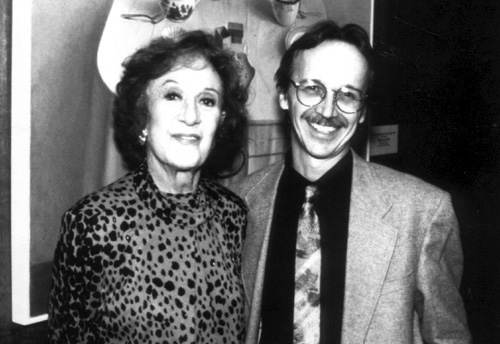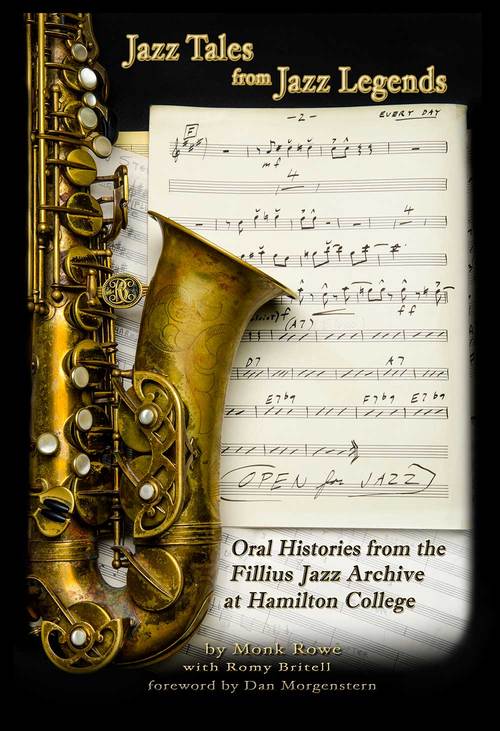Monk Rowe is a jazz musician — saxophonist, pianist, composer, arranger — and he has a day gig at Hamilton College in Clinton, New York, as the Joe Williams Director of the Filius Jazz Archive there. The Archive will be twenty-one in 2016, and it is indeed remarkably adult.
So far, Monk has conducted video interviews with more than 325 musicians, ranging from the great forbears (Doc Cheatham, Eddie Bert, Kenny Davern, Jerry Jerome, Ray Conniff, Joe Williams, Milt Hinton) to the living legends of the present and future (Nicki Parrott, Kidd Jordan, Sherrie Maricle, Bill Charlap, Holly Hofmann, Maria Schneider). And excerpts from those interviews, thematically and intelligently arranged, now form a compact yet impressive book (with a brief foreword by jazz eminence Dan Morgenstern) whose title is above.
A friend at Hamilton sent me a copy of the book some weeks back, and I have been slow to write about it — for two reasons. One, the semester got in the way, unforgivably, and two, I was often making notes and laughing so hard that I couldn’t read much at a sitting. But my instant recommendation is BUY IT. So those of you who want to skip the evidence can zoom to the bottom of this post. Others can linger.
A brief prelude. I am immensely in favor of oral history although it cannot replace the best analysis or aesthetic criticism. I wouldn’t give up Whitney Balliett, Martin Williams, Gary Giddins, Anthony Barnett, Frank Buchmann-Moller, Manfred Selchow, or John Chilton . . . the list goes on and I know I am leaving two dozen worthy writers out. But what wouldn’t we give for a ten-minute interview with Tony Fruscella, Frank Teschemacher, Jimmy Harrison, Herschel Evans, Eddie Lang, Jimmy Blanton, or Buster Bailey? True, some musicians were and are shy or not always able to articulate much about the music, but others — as we know — are born raconteurs, sharp observers, comedians, anthropologists. Their stories, no matter how brief, are precious. Two pages by Clark Terry where he speaks of being beaten by Caucasians because he was a “Nigerian” while in Mississippi — and then being rescued by another group of Caucasians — say more about race relations in the United States than twenty hours of PBS footage could ever do.
The material is organized thematically, enabling the reader to hear, for instance, stories of life on the road from Kenny Davern, Lanny Morgan, and Phil Woods. Then there are sharp observations — one can almost hear the rimshot that follows. Dave Pell calls Stan Getz “the greatest dressing room player that ever lived.” Stan Kenton stops his band from swinging too much and says, “This is not Basie. This is Stan Kenton.” Bobby Rosengarden talks about Toscanini, Joe Wilder about punctuality, Dick Hyman and Bucky Pizzarelli about life in the recording studio. Keter Betts, as a high-school student, is bought lunch by Milt Hinton; Jean Bach explains the Ellington habit of “seagulling”; Sherrie Maricle recalls her metal clarinet. Dan Barrett gives advice to young musicians. Randy Sandke talks about the perils of thinking. Karl Berger talks about his conducting; Kidd Jordan deconstructs a song’s title. And there’s a historical perspective covering nearly a century: we hear Doc Cheatham talk about Ma Rainey, then Jerry Jerome describe the first Glenn Miller band — all the way up to the present.
It’s an enthralling book. And since Monk Rowe is a professional musician, his interludes and commentary are more than useful; his questions are on the mark. Other writers put themselves into the dialogue merely to say, “Well, Dizzy always used to say to me,” but Monk is a gracious interpreter rather than a narcissist.
To find out the story of the elephant beer and the priceless answer, visit Monk’s JAZZ BACKSTORY blog here and scroll down to the bottom of the page. Then you can read the rest of Phil Woods’ words and — by the way — find out exactly what Dizzy Gillespie said when presented with the key to the city of Syracuse, New York.
JAZZ TALES FROM JAZZ LEGENDS is available here through Amazon. And the proceeds from the book support the Archives.
NEWS FLASH: Monk is going to be teaching a free online course on jazz, starting February 2, 2016: details here.
May your happiness increase!



Dear Michael: I love this for many reasons, one of which is that because my brother attended Hamilton College, I spent MANY weekends there for the four years he was enrolled :o)
Your review convinced me to buy a copy. Perhaps Monk’s next effort should be to talk to the young players who are carrying jazz–trad jazz, particularly–to the next generation (including their own). There’s already a book out by Lew Shaw compiled from his interviews with some of today’s rising (and risen) stars, but he didn’t cover the whole field.
Pingback: MONK ROWE’S TREASURE CHEST | JAZZ LIVES